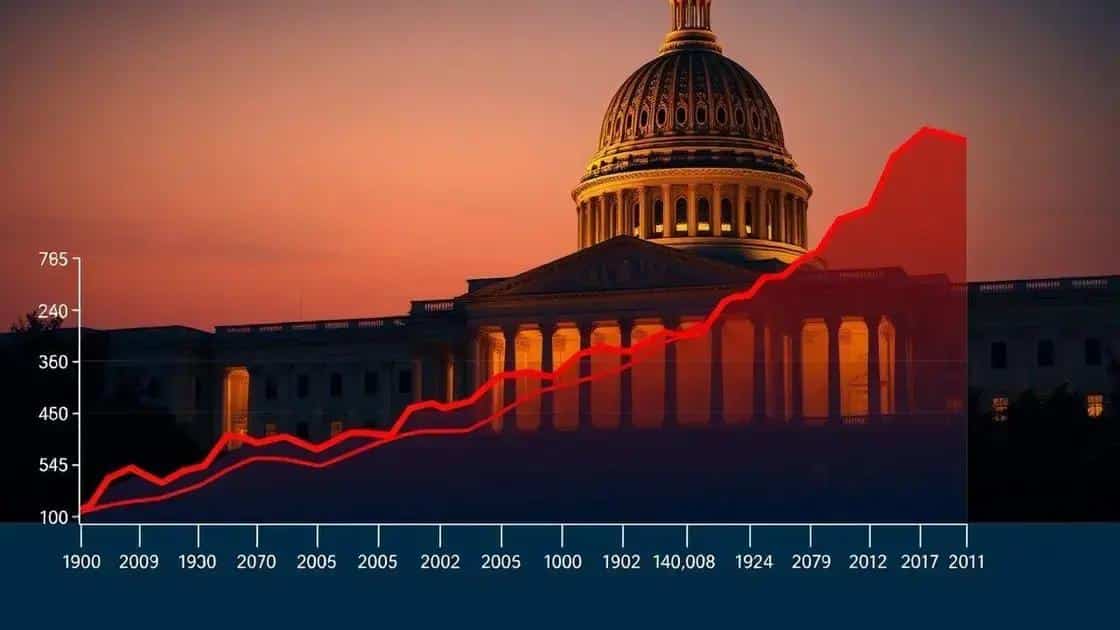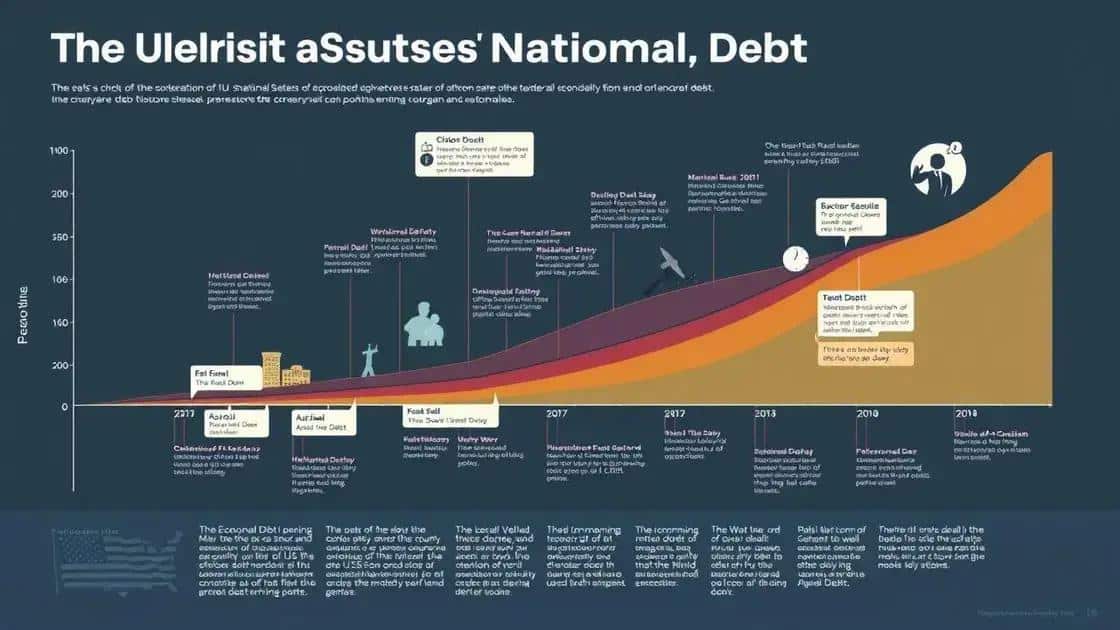U.S. national debt and its long-term effects on economy

The U.S. national debt significantly impacts future economic policies, potentially burdening upcoming generations with higher taxes, reduced public services, and limited economic growth opportunities due to government prioritization of debt management.
The U.S. national debt isn’t just a number; it’s a crucial indicator of the country’s financial health. Have you wondered how this massive debt affects everyday life and what repercussions it might have for future generations? Let’s dive into the details.
Understanding the U.S. national debt
Understanding the U.S. national debt is essential for grasping the economic landscape of the country. This debt is the total amount of money that the federal government owes to creditors. It accumulates over time when the government spends more than it earns, leading to a significant financial burden on future generations.
What Causes the National Debt?
Several factors contribute to the growth of the national debt. Primarily, it results from government expenditures exceeding revenue. When the government runs a deficit, it borrows money through issuing bonds. This process accumulates interest, increasing the total debt. Moreover, economic fluctuations and unexpected crises can lead to additional borrowing.
Key Factors Influencing the Debt
- Government Spending: Increased funding for programs such as healthcare and defense plays a significant role.
- Economic Recessions: During tough economic times, revenue decreases while spending often rises to stimulate the economy.
- Tax Policies: Changes in tax laws can reduce government income, thereby increasing the debt.
It’s also important to consider that the national debt is often reported in two categories: public debt and intragovernmental holdings. Public debt is the money that the government owes to outside creditors. In contrast, intragovernmental holdings refer to the funds the government owes itself, typically through trust funds like Social Security.
The implications of a rising national debt can be far-reaching. High levels may lead to increased interest rates, which can affect investments and economic growth. Furthermore, excessive borrowing can limit the government’s ability to respond to future crises.
Many debate whether the national debt is inherently bad or a necessary tool for economic growth. Some experts argue that as long as the economy grows at a rate faster than the debt, it can be sustainable. However, the risks associated with high debt levels make it a critical issue that policymakers must address continually.
Historical trends of national debt growth

The historical trends of national debt growth reveal how the U.S. economy has evolved over time. By examining these trends, we can gain insight into how various economic policies and events have shaped the current financial landscape. National debt began to rise significantly during major conflicts like World War II, which required extensive government spending.
Key Periods of Debt Growth
Throughout history, there have been several critical periods where national debt escalated. After World War II, the debt was significantly high but was manageable due to a booming economy. In the 1980s and early 2000s, tax cuts and increased military spending contributed to rising debt levels.
Debt Accumulation Factors
- Wars and Military Spending: Conflicts require substantial funding, leading to increased borrowing.
- Economic Stimulus: Programs aimed at stimulating the economy often involve significant expenditures.
- Recessions: Economic downturns lead to reduced tax revenue and higher spending on social programs.
The financial crisis of 2008 is another pivotal moment that resulted in massive government intervention. The costs associated with bailing out banks and stimulating the economy pushed the national debt to unprecedented levels. Since then, the trend of rising debt has continued, influenced by ongoing budget deficits.
As we look at the data, some experts suggest that the debt-to-GDP ratio is a better measure than the total debt itself. A high ratio can reflect an economy that does not grow fast enough to manage its debts. Understanding these trends helps paint a clearer picture of the complexities surrounding national debt. In the long term, it’s vital to monitor how these historical insights translate into policy decisions today.
Long-term effects on economic policies
The long-term effects of the U.S. national debt on economic policies are significant. As the national debt grows, policymakers face critical decisions that impact both current and future economic health. Understanding these effects helps us grasp how fiscal policies shape our economy.
Implications for Policy Decisions
High levels of national debt can limit a government’s ability to introduce new programs or respond to economic crises. For example, when debt is high, there may be less flexibility to implement tax cuts or increase spending on social services.
Economic Growth and Investment
- Interest Rates: A rising national debt can lead to higher interest rates as investors demand more return for purchasing government bonds.
- Inflation Control: When the national debt reaches critical levels, controlling inflation becomes challenging, leading to potential instability.
- Public Investment: Limited resources may hinder public investment in infrastructure, education, and other vital sectors.
Moreover, nations with high debt levels often face pressure to reduce spending or raise taxes. These actions can stifle economic growth, leading to a cycle of challenges that affect employment and business operations. When the government prioritizes debt repayment, it may divert funds from crucial services that support citizens.
Additionally, the burden of debt can shift to future generations. As governments prioritize debt management, they may limit opportunities for young adults, making them bear the costs of today’s decisions. The balance between managing debt and fostering economic growth is delicate; policymakers must carefully consider both sides.
Implications for future generations

The implications of the U.S. national debt for future generations are profound and far-reaching. As the national debt continues to grow, it raises important questions about who will bear the burden of repayment. Young people today could inherit a legacy of increased taxes and reduced public services due to the financial decisions made now.
Economic Burdens
One significant concern is the impact on economic opportunities. High national debt can result in slower economic growth, which can limit job creation. If the government prioritizes debt repayment, funding for education, infrastructure, and social programs may be sacrificed. This can lead to fewer opportunities for young adults as they enter the workforce.
Taxation and Public Services
- Increased Taxes: As the debt grows, future generations may face higher taxes to cover government obligations.
- Reduced Services: Essential services, such as healthcare and education, could be cut to manage the debt.
- Limited Economic Growth: A high debt burden may stifle investments in the economy.
Moreover, this situation creates a challenging environment for policymakers. They must balance debt management with providing essential services. The choice to service debt instead of investing in the future can lead to a cycle of disadvantage for younger generations.
Future generations may find themselves navigating the economic landscape shaped by the decisions made today. Awareness of these implications encourages discussions on sustainable economic policies that prioritize both debt management and opportunities for growth.
FAQ – Frequently Asked Questions about U.S. National Debt
What is the U.S. national debt?
The U.S. national debt is the total amount of money that the federal government owes to creditors, resulting from borrowing to cover budget deficits.
How does national debt affect future generations?
Future generations may face higher taxes and reduced public services as they inherit the financial burden created by today’s national debt.
Can high national debt impact economic growth?
Yes, high national debt can lead to slower economic growth, as it may limit government spending on essential services and investments.
What are the implications of national debt for taxes?
As national debt rises, there is a risk of increased taxes in the future to manage and pay off the debt incurred.





